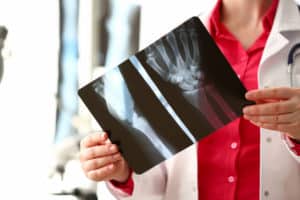Broken Bones
Home » Personal Injury Resources » Types of Injuries » Broken Bones

A broken bone probably won’t significantly alter the course of your life. Bones generally heal over a few months, and in most cases, the patient will experience no lasting effects.
But while you recover from your broken bones, you could suffer significant economic and non-economic damages. From medical bills to sleepless nights, broken bones can often represent huge challenges in your day-to-day life.
Read on to learn some facts about broken bones and what you need to prove to recover compensation for them.
Table of Contents
What Structures Make Up Your Musculoskeletal System?

The musculoskeletal system includes soft tissue and bones. The difference between soft tissue and bones lies in their composition. Bones have calcified while soft tissue has not.
Calcification makes bones strong and rigid. It also makes your bones less flexible and more brittle. Bones give your body structure. You can think of bones as your body’s frame. They can bend a bit, but too much bending will cause them to break.
Bones connect to ligaments and tendons. Ligaments connect bones. Tendons connect bones to muscles.
At their joints, bones typically include a lining made of cartilage. This material provides a tough, smooth surface for the bones to move against without grinding.
What Causes Broken Bones?
Bones fracture when they experience forces that exceed their inherent material strength. These forces could include twisting, bending, crushing, and repetitive stresses. The force a bone experiences will often determine the shape of the fracture.
Spiral Fracture
A spiral fracture takes its name from the spiral shape of the ends of the broken bone. It happens when a bone gets twisted. This can occur when your body experiences a twisting force but gets caught.
Suppose that you get into a motorcycle accident when a car hits you from the side. As you fall from your motorcycle, your body may twist. But if your leg gets trapped under the motorcycle when it tips over, you could sustain a spiral fracture in your femur or tibia.
Transverse Fracture
A transverse fracture appears as a break directly across the bone. A transverse fracture can happen from a bending motion.
When forces bend the ends of a bone, it snaps across its width. This bending motion may occur slowly, like an arm caught in a machine in a workplace accident. Or it can happen quickly, like when a car hits your leg in a pedestrian accident.
Comminuted Fracture
Doctors describe a comminuted fracture as a shattered bone. This type of fracture happens when the bone breaks into three or more pieces.
A comminuted fracture can result from a crushing injury. Crushing injuries involve pressure on the body. When the pressure overcomes the strength of a bone, it can break it into several pieces.
Stress Fracture
Normally, bones heal the microcracks they develop during ordinary activity with rest. But when you repeat a motion and do not give your body time to rest, the microcracks can grow into stress fractures.
Stress fractures typically happen in people who perform repetitive motions as part of their work. Standing, walking, lifting, and carrying all day can create and propagate stress fractures in your bones.
How Do Broken Bones Heal?
Broken bones can heal. But to ensure they heal correctly, doctors need to align the ends of the bone. This gives the body the best chance of repairing the bone and ensures the bone will have structural integrity afterward.
Treatment for broken bones depends on whether the broken ends of the bone are displaced.
Non-Displaced Fracture
In a non-displaced fracture, the broken ends of the bone remain aligned. The doctor will stabilize the bone with a cast or brace so that the broken ends remain aligned and in contact while the bone heals.
A fractured bone typically heals in six to eight weeks.
Displaced Fracture
A displaced fracture occurs when the broken ends of the bone move out of alignment after breaking. A compound fracture happens when one or both broken ends displace so far that they break the skin, creating an open wound.
Treatment of a displaced fracture often requires surgery. The doctor must realign the bones so they heal correctly. The doctor may need to secure them together with plates and screws. The doctor then stabilizes and protects the broken bone with a cast or brace.
A displaced fracture often requires more time to heal than a non-displaced fracture. A comminuted fracture—where the bone is broken in at least two different places—may take up to a year to heal.
What Are Some Complications from Broken Bones?
You can develop complications after suffering a broken bone. Some common complications include:
Infection
Infections happen when bacteria enter an open wound. Infection can develop from a compound fracture.
The bacteria destroy cells. The body battles bacteria with swelling to trap the bacteria near the wound, and fever sometimes develops as the body tries to destroy the bacteria. Doctors typically treat infection with antibiotics.
Pulmonary Embolism
When your bones begin to heal, your body forms a blood clot over the fractured ends. This blood clot protects the fracture from bacteria and traps the cells needed to heal the bone.
Occasionally, a piece of the clot breaks off and enters your bloodstream. There it can travel to your lungs and cause a pulmonary embolism. The clot blocks the blood flow into your lungs, causing your oxygen levels to drop. Without emergency treatment, you could die from a pulmonary embolism.
Nerve Damage
When you break a bone, the broken end can sever nerves as it displaces.
Severed nerves can produce symptoms in the broken limb, such as:
- Pain
- Weakness
- Muscle spasms
- Loss of dexterity
- Numbness
- Tingling
- Loss of sensation
Doctors usually cannot repair all of the small nerves torn by a displaced fracture. But your brain may remap the intact nerves to restore some functions.
Compartment Syndrome
Compartment syndrome happens when injured soft tissue swells. The swelling cuts off circulation below the injury and may cause tissue death. After you break a bone, the swelling can lead to compartment syndrome.
How Do You Recover Compensation for Broken Bones?
To get compensation for broken bones, you must prove that the fracture resulted from someone else’s negligence. In other words, a party must have breached their duty of care, resulting in your broken bones.
If you can prove this, you can recover economic damages—such as your medical expenses—and non-economic damages for pain and suffering. To learn more about the compensation you can get for your broken bones, contact the M&Y Personal Injury Lawyers today for a free consultation.
